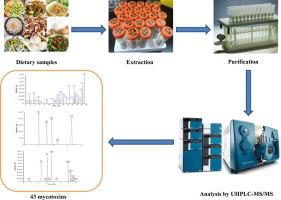Journal of Advanced Research ( IF 10.7 ) Pub Date : 2021-10-19 , DOI: 10.1016/j.jare.2021.10.008 Nannan Qiu 1 , Danlei Sun 1 , Shuang Zhou 1 , Jingguang Li 1 , Yunfeng Zhao 1 , Yongning Wu 1

|
Introduction
Mycotoxins are toxic metabolites produced by fungi that commonly contaminate foods. As recommended by the World Health Organization, total diet study (TDS) is the most efficient and effective way to estimate the dietary intakes of certain chemical substances for general populations. It requires sensitive and reliable analytical methods applicable to a wide range of complex food matrices and ready-to-eat dishes.
Objectives
A novel strategy with high selectivity and sensitivity, incorporating three methods based on ultra-high-performance liquid chromatography coupled with tandem mass spectrometry (UHPLC-MS/MS), was designed for measuring 43 mycotoxins in dietary samples in a China TDS.
Methods
The 43 mycotoxins were divided into 3 groups for analysis to achieve better performance. For each group, an UHPLC-MS/MS method was developed to determine the target compounds after clean-up by solid phase extraction. A total of 21 isotope internal standards were employed for accurate quantitation. Method validation in terms of linearity, selectivity, sensitivity, accuracy, and precision was performed for all the 43 mycotoxins in 12 complex food matrices.
Results
The limits of detection (LODs) and limits of quantitation (LOQs) were 0.002–1 ng mL−1 and 0.006–3 ng mL−1, respectively. The method recoveries of the 43 mycotoxins spiked in 12 food categories were in the range of 60.3%–175.9% after internal standard correction, with relative standard deviations (RSDs) below 13.9%. For practical application, this method was utilized for 72 dietary samples collected from 6 provinces in the 6th China TDS. More than 80% of the samples were found contaminated by mycotoxins. DON, SMC, FB1, ZEN, BEA, ENNB1, and ENNB were most detected.
Conclusions
The proposed methods with high sensitivity, accuracy, and robustness provide powerful tools for multi-mycotoxin monitoring and dietary exposure assessment, allowing 43 mycotoxins, including some emerging mycotoxins, to be accurately investigated in a total diet study for the first time.



























 京公网安备 11010802027423号
京公网安备 11010802027423号